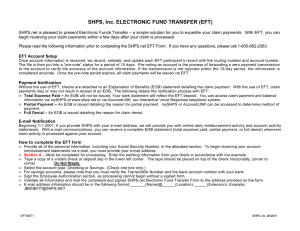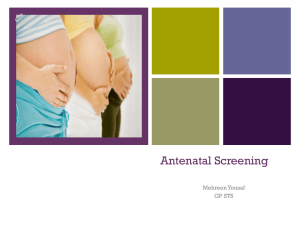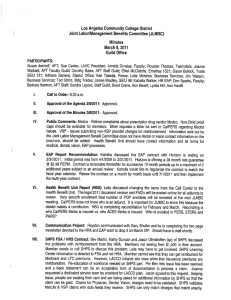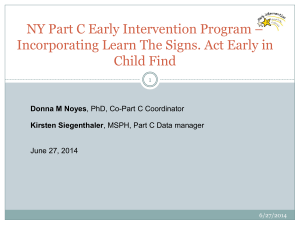Update on the Affordable Care Act: Impacts on College Student
advertisement
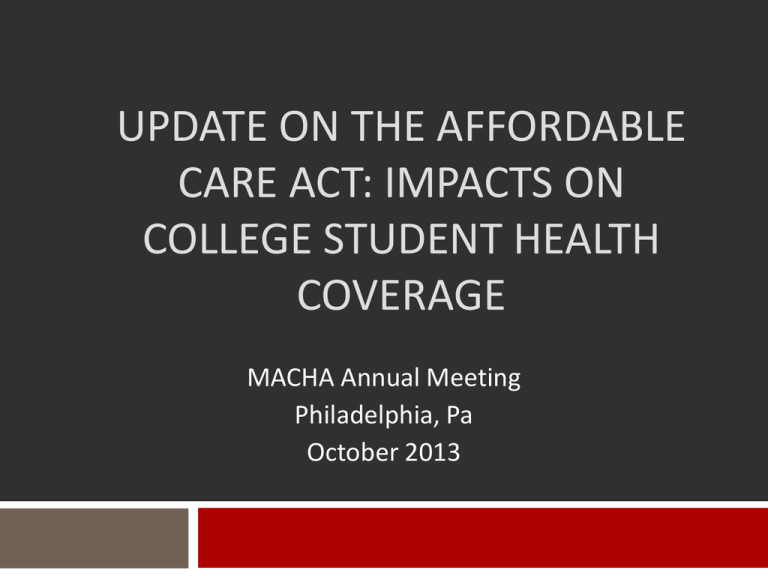
UPDATE ON THE AFFORDABLE CARE ACT: IMPACTS ON COLLEGE STUDENT HEALTH COVERAGE MACHA Annual Meeting Philadelphia, Pa October 2013 Focus of Advocacy Efforts Forecasting impacts of the Marketplace on SHPs Recognition of SHPs as an option in Marketplace and other communications Defining the relationship between international students and the access to the Marketplace and subsidy Providing support for members engaged in state advocacy on Medicaid and patient privacy Determining if there is a path to tax subsidy for students purchasing SHPs Impacts: Marketplace Opening Many schools do not offer plans or do not offer robust plans Hard waiver processes – Can SHPs survive without one? Unlikely SHPs will ever be a Marketplace option How competitive are we? What about subsidy? Premium Expectations Average of 53 qualified plans Categorized as “platinum,” “gold,” “silver,” or “bronze” Young adults – average of 57 when catastrophic plans are factored in Preventive care + 3 primary care visits/yr Lower than expected premiums Rules of Engagement Beginning on January 1, 2014 Annual limits for “essential health benefits” are prohibited Must cover all essential health benefits No pre-existing condition exclusions ACA Essential Benefits Ambulatory patient services Emergency services Hospitalization Maternity and newborn Mental health and substance use services Prescription drugs Rehabilitative and habilitative services and devices Laboratory Preventive and wellness services and chronic disease management Pediatric services, including oral and vision Covered Preventive One time screening for abdominal aortic aneurysm – male smokers of specified age Alcohol misuse screening and counseling Aspirin use for men and women of certain ages Blood pressure screening for all adults Cholesterol screening for adults of certain age Colorectal Cancer screening over 50 yr Depression screening – adults Type 2 Diabetes screening for adults with HBP Diet Counseling for adults at higher risk for chronic disease HIV screening for all adults at higher risk Immunization vaccines – according to vaccine schedule Obesity screening and counseling – all adults STI prevention counseling Tobacco use screening for all adults and cessation interventions for users Syphilis screening for all adults at higher risk Marketing List as an option on HHS communication List as an option in marketing by Young Invincibles – digital media toolkit HHS efforts to engage college campuses “Opt Out” campaign http://news.yahoo.com/obamacare-battle-moves-tocollege-campuses-200027191.html International Student Issues Eligibility to participate in the Exchange Definition of “lawfully present” US citizen/nationals Aliens – lawfully present Immigrants – green card holder Not Non-immigrants – F1,J1, H1, etc. subject to a residency requirement if they are legally present International Student Issues Taxes and the international student All pay income tax unless they are exempt based on a tax treaty agreement with their country You can be a non-immigrant but a resident for tax purposes. City, State and Federal govs have different definitions of residents for tax purposes. International students are ineligible for many forms of tax relief/subsidy International Student Issues Access to tax subsidy for insurance purchased in the Marketplace Eligibility for tax subsidy for insurance it would be a departure from norm It appears that they are eligible for premium subsidies if they self-attest for having income for 2014 of $15,900 or more as an individual. it does not appear that international students will be qualifying for premium subsidies, except in rare instances where there is income from a spouse Medicaid Advocacy Primer is on ACHA website Medicaid issues will probably become even more confusing with some states opting for expansion and some not (29 currently expanding) BasicHealthPlan regulation just posted to the Federal Register to fill the gap for low income persons in states that did not accept expansion Movement in some states toward consideration for use of Medicaid dollars to purchase SHPs EOBs and Patient Confidentiality Primary purpose of the EOB - increase transparency and decrease fraud by providing subscribers with information about services applied to the policy Providing EOBs varies by state Has historically created a barrier to care for adolescents under parents plans ACA expansion of access to insurance under parents for young adults to age 26 has exacerbated the issue May become more problematic as student health services move to third party billing Ensuring Confidentiality: A State Advocacy Issue • “On the issue of disclosing minors’ protected health information to parents, HIPAA defers to “state or other applicable law,” and if the relevant law is silent on this issue, the regulation gives discretion to health care providers to determine whether to disclose such information to the parent.” English, A., Gold, R.B., Nash, E., & Levine, J. (2012). Confidentiality for individuals insured as dependents: A review of state laws and policies. Guttmacher Institute and Public Health Solutions. doi:http://www.guttmacher.org/pubs/confidentiality-review.pdf What is the rule in your state? Protection Afforded by States* EOB not sent when no balance is due EOB may be sent to patient New York, Wisconsin Confidential STI treatment for minors, including in billing process New York, Wisconsin Connecticut, Delaware, Florida General confidentiality provisions Health care provider must inform insurer when “minors without support” request confidentiality Minor may refuse parents’ request for EOB or claim denial Hawaii Maine Insurer may not disclose private health information, including by mailing an EOB, without authorization of minor or adult patient Washington *English, A., Gold, R.B., Nash, E., & Levine, J. (2012). Confidentiality for individuals insured as dependents: A review of state laws and policies. Guttmacher Institute and Public Health Solutions. doi:http://www.guttmacher.org/pubs/confidentiality-review.pdf Options for Ensuring Patient Confidentiality Suppress the EOB if there are no out-of-pocket costs for care Send the EOB only to the person receiving the care even if they are not the principle policy holder Allow covered individuals to access their payment from additional means (i.e. electronic) Allow covered individuals to request suppression of summary of payment forms Decrease the detailed content of EOBs Resources www.HealthCare.gov http://younginvincibles.org/issues/health-care/ http://www.advisory.com/DailyBriefing/Resources/Primers/MedicaidMap

